Summer is big. The excitement of vacations, travel, catching up on reading, and, of course, the classroom is never far from mind. This year has been so fruitful in literature that we had to break our summertime books into two parts. Check out last week’s first installment for even more titles.
Ages 4–8
See You Next Year. Andrew Larsen. 2015. Ill. Todd Stewart. Owlkids.
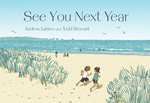 In this story depicting one family and their summer vacation, readers meet a girl whose family takes a beach vacation. “Every year we stay at the same place./I call it our cottage./But it’s not really a cottage./It’s a motel.” They come on Saturday and spend a week, they have done that since she was little. She likes the changelessness of the family summer tradition, and she tells readers about their days and meeting a new friend, who taught her how to swim. On a foggy day they write postcards, but on most days everyone goes to the beach with “beach stuff and their towels and their coolers” and their colorful umbrellas. The illustrations, in tones of yellow and red, with fresh, intense blues, are digitally created, resembling silk screen prints. Their clean, tactile quality has the appearance of chalk pastel, gouache, and pen and ink. Most striking are the azure blues of the sky during the day juxtaposed to the deep blue of summer nights. The red umbrellas at the beach, arrayed across two pages, show the energy of the morning. The postcard writing is part of an unexpected ending depicted in a final illustration that provides more detail of the girl’s vacation.
In this story depicting one family and their summer vacation, readers meet a girl whose family takes a beach vacation. “Every year we stay at the same place./I call it our cottage./But it’s not really a cottage./It’s a motel.” They come on Saturday and spend a week, they have done that since she was little. She likes the changelessness of the family summer tradition, and she tells readers about their days and meeting a new friend, who taught her how to swim. On a foggy day they write postcards, but on most days everyone goes to the beach with “beach stuff and their towels and their coolers” and their colorful umbrellas. The illustrations, in tones of yellow and red, with fresh, intense blues, are digitally created, resembling silk screen prints. Their clean, tactile quality has the appearance of chalk pastel, gouache, and pen and ink. Most striking are the azure blues of the sky during the day juxtaposed to the deep blue of summer nights. The red umbrellas at the beach, arrayed across two pages, show the energy of the morning. The postcard writing is part of an unexpected ending depicted in a final illustration that provides more detail of the girl’s vacation.
Uh-Oh! Shutta Crum. 2015. Ill. Patrice Barton. Knopf/Random House Children’s Books.
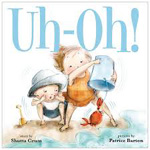 In this almost-wordless picture book, the delighted antics and play of two children out for the day at the beach with their female caretakers are depicted in multiple illustrations in double-page spreads. The only word that appears on some of the pages when play takes an unexpected turn is “Uh-Oh.” The little girl’s sunglasses fall off her face into the puddle of water they are digging, followed by a misguided decision to shove the little boy’s milk bottle into the sand mound. The children show resourcefulness in solving the problems of the uh-oh moment. The bottle becomes a nose for the face and the glasses become the eyes. The two children change their play area away from the sand by the water to the swings where more unexpected things happen and where they discover a crab in their bucket: “Uh-Oh.” The story of their imaginative play is depicted in bright summery colors, with a preponderance of blue, rendered in graphite, colored pencil, and watercolor. The enchanting, charming expressions of the children will evoke much laughter in re-readings as readers find additional details in the antics.
In this almost-wordless picture book, the delighted antics and play of two children out for the day at the beach with their female caretakers are depicted in multiple illustrations in double-page spreads. The only word that appears on some of the pages when play takes an unexpected turn is “Uh-Oh.” The little girl’s sunglasses fall off her face into the puddle of water they are digging, followed by a misguided decision to shove the little boy’s milk bottle into the sand mound. The children show resourcefulness in solving the problems of the uh-oh moment. The bottle becomes a nose for the face and the glasses become the eyes. The two children change their play area away from the sand by the water to the swings where more unexpected things happen and where they discover a crab in their bucket: “Uh-Oh.” The story of their imaginative play is depicted in bright summery colors, with a preponderance of blue, rendered in graphite, colored pencil, and watercolor. The enchanting, charming expressions of the children will evoke much laughter in re-readings as readers find additional details in the antics.
Up in the Garden and Down in the Dirt. Kate Messner. 2015. Ill. Christopher Silas Neal. Chronical Books.
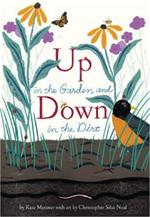 In this tall picturebook readers see what is above the ground level and beneath, in the soil, through the year, from planting, to the heat of summer, the long season of harvest, and the increasing cold of winter, when life continues underground. Messner begins the narrative in spring and writes, “Up in the garden, it’s time to plant. I trail a furrow with my finger and sprinkle seeds in a careful row” (unpaged). Nana, the narrator’s companion works along side her in the raised beds that will be the home of vegetables and flowers. Messner writes, “Down in the dirt, a tomato hornworm rests, waiting for wings—and the leaves where she’ll lay her eggs.” In each succeeding double-page illustration is the seasonal juxtaposition of up in the garden and down in the dirt, showing how life is vigorous and changing above ground and below the surface. Life is also vigorous on the ground with the number of animals who feed on insects and other animals, including the garter snake who feasts on grasshoppers, the skunk and robin who eat a number of different animals including grubs and slugs, and the long-legged spider, who does not build a nest. In this nonfiction book Messner shares information related to growing plants and the unsung heroes that are part of the garden and that ensure its health. Messner provides information about happens to plants above ground and the life underground. Of the twenty-three double page illustrations done in multi media and soft muted tones, only three of them have different illustrations on each page, making this book one to come back to again and again for all its detail. The back matter includes sources for further reading and discussion of each of the animals that are featured in the story. Messner does make the case that any garden is a community garden.
In this tall picturebook readers see what is above the ground level and beneath, in the soil, through the year, from planting, to the heat of summer, the long season of harvest, and the increasing cold of winter, when life continues underground. Messner begins the narrative in spring and writes, “Up in the garden, it’s time to plant. I trail a furrow with my finger and sprinkle seeds in a careful row” (unpaged). Nana, the narrator’s companion works along side her in the raised beds that will be the home of vegetables and flowers. Messner writes, “Down in the dirt, a tomato hornworm rests, waiting for wings—and the leaves where she’ll lay her eggs.” In each succeeding double-page illustration is the seasonal juxtaposition of up in the garden and down in the dirt, showing how life is vigorous and changing above ground and below the surface. Life is also vigorous on the ground with the number of animals who feed on insects and other animals, including the garter snake who feasts on grasshoppers, the skunk and robin who eat a number of different animals including grubs and slugs, and the long-legged spider, who does not build a nest. In this nonfiction book Messner shares information related to growing plants and the unsung heroes that are part of the garden and that ensure its health. Messner provides information about happens to plants above ground and the life underground. Of the twenty-three double page illustrations done in multi media and soft muted tones, only three of them have different illustrations on each page, making this book one to come back to again and again for all its detail. The back matter includes sources for further reading and discussion of each of the animals that are featured in the story. Messner does make the case that any garden is a community garden.
Ages 9–11
Gone Crazy in Alabama. Rita Williams-Garcia. 2015. Amistad/HarperCollins.
 Delphine, Vonetta, and Fern leave Brooklyn, their father, and “Mrs.” to spend the summer with their grandmother and great-grandmother, Ma Charles. They are enchanted by the life on the family’s farm with fresh eggs and milk and the garden but perhaps less charmed by the expectations for good manners their grandmother has for them. They visit their Aunt Trotter across the stream from Ma Charles’s house and learn the history of the family from both of them, each sister adding to the chronicle the other has reported. Delphine concludes that two sisters who live so close together who have not seen each other since they were children is crazy and the craziness of the history and of the local customs continues to reveal itself to the girls. The girls learn of the relationships between the Creek and Choctaw Tribes and their ancestors and learn they are related to the white sheriff, who is a Ku Klux Klan member. Garcia has included a family genealogy in the back matter readers will need to refer to as they hear details of U.S. history through the sisters. The year is 1969, and the girls witness the rising tensions prevalent in southern towns as they find that their lessons of liberation and empowerment from their mother and Mrs. don’t count. Their grandmother wants to protect the girls and promote values of respectable families, but no one is protected from a tornado that changes most everything.
Delphine, Vonetta, and Fern leave Brooklyn, their father, and “Mrs.” to spend the summer with their grandmother and great-grandmother, Ma Charles. They are enchanted by the life on the family’s farm with fresh eggs and milk and the garden but perhaps less charmed by the expectations for good manners their grandmother has for them. They visit their Aunt Trotter across the stream from Ma Charles’s house and learn the history of the family from both of them, each sister adding to the chronicle the other has reported. Delphine concludes that two sisters who live so close together who have not seen each other since they were children is crazy and the craziness of the history and of the local customs continues to reveal itself to the girls. The girls learn of the relationships between the Creek and Choctaw Tribes and their ancestors and learn they are related to the white sheriff, who is a Ku Klux Klan member. Garcia has included a family genealogy in the back matter readers will need to refer to as they hear details of U.S. history through the sisters. The year is 1969, and the girls witness the rising tensions prevalent in southern towns as they find that their lessons of liberation and empowerment from their mother and Mrs. don’t count. Their grandmother wants to protect the girls and promote values of respectable families, but no one is protected from a tornado that changes most everything.
Ice Cream Summer. Peter Sís. 2015. Scholastic.
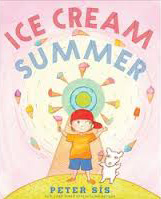 The book’s sunny, breezy tone is established through a letter a boy writes to his grandfather explaining how busy he is. “But don’t worry, I am not forgetting about school. I read every day.” In bright pastel illustrations, Sís depicts the boy explaining all the rigorous activities he is doing, in serif text at the bottom of each page, while the true meaning of the letter’s words is conveyed in the illustrations. His letter says he is “conquering big words like tornado and explosion” as he gazes at a vast ice cream selection including Cherry Tornado and Mango Explosion. “I practice my math facts” as he counts scoops of ice cream and figures word problems: “If ice cream costs 50 cents a scoop and I have $2.00 in my pocket, how many scoops can I get?” Readers will certainly pore over the illustration of his study of ancient China. Sís explains in the illustration, “2,000 years ago: First ice cream.” The flowchart that spreads across the two pages shows how the Chinese made ice cream that included not only milk, snow, and fruit, but rice. Sís includes information in his “discovery of great inventors” in U.S. history: In 1920, Harry Burt invented ice cream on sticks. In the front matter, Sís explains his thinking and the research for the book and provides the sources he has used to find ice cream information, yet the charm of the book with its pastel-toned illustrations invites re-readings.
The book’s sunny, breezy tone is established through a letter a boy writes to his grandfather explaining how busy he is. “But don’t worry, I am not forgetting about school. I read every day.” In bright pastel illustrations, Sís depicts the boy explaining all the rigorous activities he is doing, in serif text at the bottom of each page, while the true meaning of the letter’s words is conveyed in the illustrations. His letter says he is “conquering big words like tornado and explosion” as he gazes at a vast ice cream selection including Cherry Tornado and Mango Explosion. “I practice my math facts” as he counts scoops of ice cream and figures word problems: “If ice cream costs 50 cents a scoop and I have $2.00 in my pocket, how many scoops can I get?” Readers will certainly pore over the illustration of his study of ancient China. Sís explains in the illustration, “2,000 years ago: First ice cream.” The flowchart that spreads across the two pages shows how the Chinese made ice cream that included not only milk, snow, and fruit, but rice. Sís includes information in his “discovery of great inventors” in U.S. history: In 1920, Harry Burt invented ice cream on sticks. In the front matter, Sís explains his thinking and the research for the book and provides the sources he has used to find ice cream information, yet the charm of the book with its pastel-toned illustrations invites re-readings.
The Island of Dr. Libris. Chris Grabenstein. 2015. Random House.
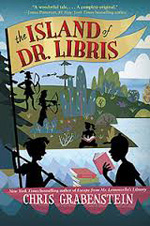 Billy’s parents have rented a log cabin for the summer from Dr. Xiang (X) Libris—a place where his mother can write her dissertation and his father can leave them while he goes back to the city. Billy is without television, Xbox, or iPhone while he helps one of his next-door neighbors, Alyssa. His mother suggests he find the key to a remarkable bookcase as an activity, but that mystery unlocks others in this fast-paced, action-packed story. When he finally opens the bookcase and reads Robin Hood and his Merry Men and the Greek myths of Hercules and Poseidon, he hears them talk to one another. Certain he needs a distraction, Billy sets out to the island in sight of his log cabin. There he discovers Robin and Maid Marian in one place and Hercules fighting in another. They challenge one another, and Billy steps in to forge a strange alliance. Billy must figure out what Dr. Libris is up to, fend off the local bullies, organize the growing number of characters appearing on the island, and help his family. In the process, he befriends Walter, Alyssa’s brother, who becomes an ally in solving multiple mysteries for which the two boys enlist other literary characters including Pollyanna and Tom Sawyer. The novel, rich in literary references, includes a long section in the back matter listing all the books and authors who figure in the story, yet the book also includes cultural references such as the artwork of M.C. Escher. A combination of realistic fiction, fantasy, and folklore, this adventure story is an adventure in reading.
Billy’s parents have rented a log cabin for the summer from Dr. Xiang (X) Libris—a place where his mother can write her dissertation and his father can leave them while he goes back to the city. Billy is without television, Xbox, or iPhone while he helps one of his next-door neighbors, Alyssa. His mother suggests he find the key to a remarkable bookcase as an activity, but that mystery unlocks others in this fast-paced, action-packed story. When he finally opens the bookcase and reads Robin Hood and his Merry Men and the Greek myths of Hercules and Poseidon, he hears them talk to one another. Certain he needs a distraction, Billy sets out to the island in sight of his log cabin. There he discovers Robin and Maid Marian in one place and Hercules fighting in another. They challenge one another, and Billy steps in to forge a strange alliance. Billy must figure out what Dr. Libris is up to, fend off the local bullies, organize the growing number of characters appearing on the island, and help his family. In the process, he befriends Walter, Alyssa’s brother, who becomes an ally in solving multiple mysteries for which the two boys enlist other literary characters including Pollyanna and Tom Sawyer. The novel, rich in literary references, includes a long section in the back matter listing all the books and authors who figure in the story, yet the book also includes cultural references such as the artwork of M.C. Escher. A combination of realistic fiction, fantasy, and folklore, this adventure story is an adventure in reading.
Ages 12–14
Revolution. Deborah Wiles. 2014. Scholastic.
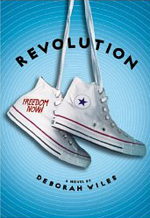 The summer of 1964 in the life of Sunny and her family in Greenwood, Missouri, is a layered story of many characters. Sunny’s problems with her stepbrother, Gillette, and her stepmother are compounded by more family members moving into her father’s house. Wiles chronicles what members of the white supremacists called “the invasion of the agitators,” when people from all over the United States came to Mississippi to undertake community projects, including voter registration and education. The racist views of white segregationists for whom Federal Civil Rights legislation was wrong and unconstitutional are at first polite, but become hateful and inflammatory. According to they, the local customs had to be preserved yet, in both the African American and parts of the white community, freedom, empowerment, and integration became more than a rallying cry. The places of Sunny’s favorite activities—the municipal pool, the local movie theater, restaurants for family dinners—all become places of conflict. The novel’s montage of archival photographs and multiple narratives provide context for the escalating tensions that climax in violence. The secrets Sunny holds in her heart perhaps start with her sense of alienation from her stepmother, but certainly her trespass into the pool one night with Gillette, where they meet an African American, weighs heavily. Seeing him later at the movie theater, she calls him High Top, a reference to his Converse All-Star sneakers. Raymond Bullis, freedom fighter, is also known to her stepbrother, who plays ball with the African American players on their ball field—more secrets. While the world explodes in gunfire and violence around her, Sunny comes to understand both herself and her relationship with her family. Wiles explains that she was born in Alabama and spent summers in Mississippi and the “Note about Freedom Summer” provides additional context for the novel.
The summer of 1964 in the life of Sunny and her family in Greenwood, Missouri, is a layered story of many characters. Sunny’s problems with her stepbrother, Gillette, and her stepmother are compounded by more family members moving into her father’s house. Wiles chronicles what members of the white supremacists called “the invasion of the agitators,” when people from all over the United States came to Mississippi to undertake community projects, including voter registration and education. The racist views of white segregationists for whom Federal Civil Rights legislation was wrong and unconstitutional are at first polite, but become hateful and inflammatory. According to they, the local customs had to be preserved yet, in both the African American and parts of the white community, freedom, empowerment, and integration became more than a rallying cry. The places of Sunny’s favorite activities—the municipal pool, the local movie theater, restaurants for family dinners—all become places of conflict. The novel’s montage of archival photographs and multiple narratives provide context for the escalating tensions that climax in violence. The secrets Sunny holds in her heart perhaps start with her sense of alienation from her stepmother, but certainly her trespass into the pool one night with Gillette, where they meet an African American, weighs heavily. Seeing him later at the movie theater, she calls him High Top, a reference to his Converse All-Star sneakers. Raymond Bullis, freedom fighter, is also known to her stepbrother, who plays ball with the African American players on their ball field—more secrets. While the world explodes in gunfire and violence around her, Sunny comes to understand both herself and her relationship with her family. Wiles explains that she was born in Alabama and spent summers in Mississippi and the “Note about Freedom Summer” provides additional context for the novel.
Sandip LeeAnne Wilson serves as associate professor of Literacy Education and English at Husson University, Bangor, ME. She serves on the Board of the New England Reading Association and the Notable Books for a Global Society Committee of the Children’s Literature and Reading Special Interest Group. The review contributions are provided by members of the International Literacy Association’s Children’s Literature and Reading Special Interest Group.